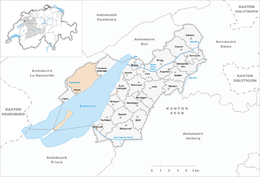Twann
| Twann | ||
|---|---|---|
| Former municipality of Switzerland | ||
|
||
| Coordinates: 47°5′N 7°9′E / 47.083°N 7.150°ECoordinates: 47°5′N 7°9′E / 47.083°N 7.150°E | ||
| Country | Switzerland | |
| Canton | Bern | |
| District | Nidau | |
| Area | ||
| • Total | 9.1 km2 (3.5 sq mi) | |
| Elevation | 434 m (1,424 ft) | |
| Population (December 2007) | ||
| • Total | 818 | |
| • Density | 90/km2 (230/sq mi) | |
| Postal code | 2513 | |
| SFOS number | 0753 | |
| Surrounded by | Erlach, Hagneck, Lamboing, La Neuveville, Ligerz, Lüscherz, Mörigen, Prêles, Sutz-Lattrigen, Täuffelen, Tüscherz-Alfermée, Vinelz | |
| Website | SFSO statistics |
|
Twann (French: Douanne) was a municipality in the district of Nidau in the canton of Bern in Switzerland. On 1 January 2010 the municipalities of Tüscherz-Alfermée and Twann merged into the municipality of Twann-Tüscherz.
Twann is first mentioned in 1185 as Duana. In 1225 it was mentioned as Tuanna.
Just outside the Twann train station is a large and well preserved neolithic lakeside settlement. It was discovered in the mid 19th century and in 1974-76 about 10% of the total site was excavated. Almost 20 different village existed at the site between 3838 and 2976 BC. The longest a single village was inhabited was only 24 years. The small huts (7 m × 4 m [23 ft × 13 ft]) were only temporary and most had to be repaired after less than four years and replaced after sixteen. The huts stood in serried ranks either longitudinally or transversely oriented to the lake. The hut floors had a layer of peat to keep them dry and a clay hearth in the center. The residents used hoes, sticks and simple plows to raise grain which was eaten as a porridge or bread. They raised domestic cattle, sheep and goats constantly and hunted animals, mostly red deer, as needed. They often fished in the lake. They wore clothes made of woven flax and bark fibers. An incised ceramic vessel shows trade links to Valais and a rock crystal shows that they traded with other alpine villages. About half of their flint tools came from local flint sources, while the rest of the flint from distant regions including southern Germany, the southern Rhone Valley and Champagne. One copper knife blade was also discovered at the site.
The other prehistoric sites include a Roman cremation grave in Rogget, early medieval finds in Gaicht and a burial ground in Gauchete.
...
Wikipedia



